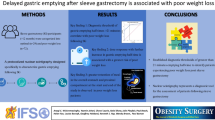Abstract
Background
Laparoscopic sleeve gastrectomy (LSG) is generally considered a restrictive procedure. However, studies with nuclear medicine techniques have demonstrated that gastric motility changes occur following LSG. These motility changes could represent complementary mechanisms of weight loss. Therefore, we analyzed the stomach motility before and after LSG by means of dynamic MRI.
Methods
In this prospective pilot study, five female patients with a mean BMI of 51.6 kg/m2 underwent MRI 1 day before LSG and 6 days and 6 months after LSG. Dynamic steady-state free precession sequences were used to analyze the gastric motility after ingestion of 500 ml water with a temporal resolution of 0.86 s. Axial image stacks were also repeatedly acquired to determine the intragastric fluid volume over time.
Results
Mean excess body mass index loss was 60.6% after 6 months. Dynamic analysis showed that antral propulsive peristalsis was preserved immediately after surgery and during follow-up, but fold speed increased significantly from 2.7 mm/s before LSG to 4.4 mm/s after 6 months. The sleeve itself remained without recognizable peristalsis in three patients and showed only uncoordinated or passive motion in two patients. Consequently, the fluid transport through the sleeve was markedly delayed, whereas the antrum showed accelerated propulsion with the emptying half-time decreasing from 16.5 min preoperatively to 7.9 min 6 months after surgery.
Conclusions
Owing to the LSG procedure, the stomach is functionally divided into a sleeve without propulsive peristalsis and an accelerated antrum. Accelerated emptying seems to be caused by faster peristaltic folds.



Similar content being viewed by others
References
Buchwald H, Avidor Y, Braunwald E, et al. Bariatric surgery: a systematic review and meta-analysis. Jama. 2004;292:1724–37.
Hess DS, Hess DW. Biliopancreatic diversion with a duodenal switch. Obes Surg. 1998;8:267–82.
Iannelli A, Schneck AS, Dahman M, et al. Two-step laparoscopic duodenal switch for superobesity: a feasibility study. Surg Endosc. 2009;23:2385–9.
Menenakos E. K MS, Albanopoulos K, et al. Laparoscopic sleeve gastrectomy performed with intent to treat morbid obesity: a prospective single-center study of 261 patients with a median follow-up of 1 year. Obes Surg. 2010;20:276–82.
Moon Han S, Kim WW, Oh JH. Results of laparoscopic sleeve gastrectomy (LSG) at 1 year in morbidly obese Korean patients. Obes Surg. 2005;15:1469–75.
Skrekas G, Lapatsanis D, Stafyla V, et al. One year after laparoscopic “tight” sleeve gastrectomy: technique and outcome. Obes Surg. 2008;18:810–3.
Bernstine H, Tzioni-Yehoshua R, Groshar D, et al. Gastric emptying is not affected by sleeve gastrectomy—scintigraphic evaluation of gastric emptying after sleeve gastrectomy without removal of the gastric antrum. Obes Surg. 2009;19:293–8.
Braghetto I, Davanzo C, Korn O, et al. Scintigraphic evaluation of gastric emptying in obese patients submitted to sleeve gastrectomy compared to normal subjects. Obes Surg. 2009;19:1515–21.
Melissas J, Daskalakis M, Koukouraki S, et al. Sleeve gastrectomy—a “food limiting” operation. Obes Surg. 2008;18:1251–6.
Melissas J, Koukouraki S, Askoxylakis J, et al. Sleeve gastrectomy: a restrictive procedure? Obes Surg. 2007;17:57–62.
Abell TL, Camilleri M, Donohoe K, et al. Consensus recommendations for gastric emptying scintigraphy: a joint report of the American Neurogastroenterology and Motility Society and the Society of Nuclear Medicine. Am J Gastroenterol. 2008;103:753–63.
Odunsi ST, Camilleri M. Selected interventions in nuclear medicine: gastrointestinal motor functions. Semin Nucl Med. 2009;39:186–94.
Atkinson DJ, Edelman RR. Cineangiography of the heart in a single breath hold with a segmented turboFLASH sequence. Radiology. 1991;178:357–60.
Breyer T, Echternach M, Arndt S, et al. Dynamic magnetic resonance imaging of swallowing and laryngeal motion using parallel imaging at 3 T. Magn Reson Imaging. 2009;27:48–54.
Waterton JC, Jenkins JP, Zhu XP, et al. Magnetic resonance (MR) cine imaging of the human heart. Br J Radiol. 1985;58:711–6.
Krawczykowski D. La sleeve gastrectomy. Acta Endoscopica. 2008;38:S57–62.
Carmichael AR, Johnston D, Barker MC, et al. Gastric emptying after a new, more physiological anti-obesity operation: the Magenstrasse and Mill procedure. Eur J Nucl Med. 2001;28:1379–83.
Santini F, Wetzel SG, Bock J, et al. Time-resolved three-dimensional (3D) phase-contrast (PC) balanced steady-state free precession (bSSFP). Magn Reson Med. 2009;62:966–74.
Terra MP, Stoker J. The current role of imaging techniques in faecal incontinence. Eur Radiol. 2006;16:1727–36.
Castillo E, Lima JA, Bluemke DA. Regional myocardial function: advances in MR imaging and analysis. Radiographics. 2003;23:S127–40.
Treier R, Steingoetter A, Weishaupt D, et al. Gastric motor function and emptying in the right decubitus and seated body position as assessed by magnetic resonance imaging. J Magn Reson Imaging. 2006;23:331–8.
Kwiatek MA, Steingoetter A, Pal A, et al. Quantification of distal antral contractile motility in healthy human stomach with magnetic resonance imaging. J Magn Reson Imaging. 2006;24:1101–9.
Sanjeevi A. Gastric motility. Curr Opin Gastroenterol. 2007;23:625–30.
Hirst GD, Edwards FR. Electrical events underlying organized myogenic contractions of the guinea pig stomach. J Physiol. 2006;576:659–65.
Gagner M. Faster gastric emptying after laparoscopic sleeve gastrectomy. Obes Surg. 2010;20:964–5. author reply 966–7.
Conflicts of interest
The authors declare that they have no conflict of interest.
Author information
Authors and Affiliations
Corresponding author
Additional information
T. Baumann and S. Kuesters contributed equally to this work.
Rights and permissions
About this article
Cite this article
Baumann, T., Kuesters, S., Grueneberger, J. et al. Time-Resolved MRI After Ingestion of Liquids Reveals Motility Changes After Laparoscopic Sleeve Gastrectomy—Preliminary Results. OBES SURG 21, 95–101 (2011). https://doi.org/10.1007/s11695-010-0317-6
Published:
Issue Date:
DOI: https://doi.org/10.1007/s11695-010-0317-6




